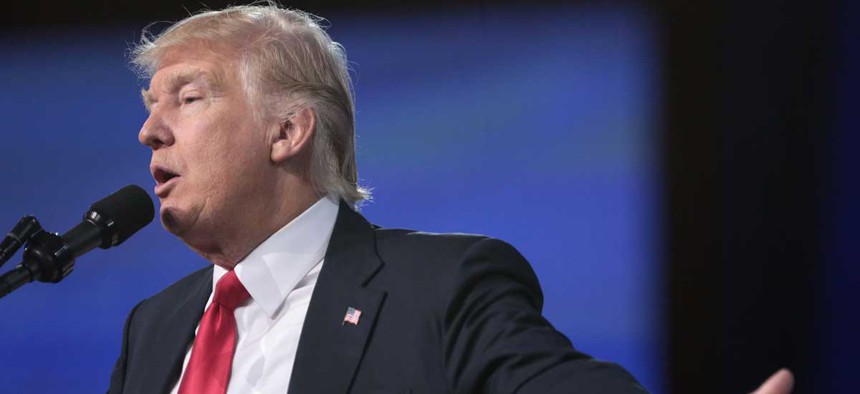Is Trump Still Tweeting From His Unsecured Android Phone?
If so, he’s extremely vulnerable to being hacked.
There are two personalities on display in Donald Trump’s Twitter feed. One Trump generally spells things correctly, tweets flattering news stories, and politely thanks visitors for meeting with him. The other Trump is easily provoked, capitalizes random words, and lashes out in real time at things that annoy him.
These two genres of tweets generally come from two different devices—an Android phone and an iPhone—and thus presumably from different people. Last year, David Robinson, a data scientist at Stack Overflow, poked through months of Trump’s timeline and found that tweets from the Android phone were far more negative than the bland iPhone tweets. Trump uses an Android phone as his personal device, suggesting that he was behind the angrier tweets; the iPhone tweets probably came from staff.
To help The Atlantic’s journalists guess whether any given tweet comes from an aide or straight from Trump’s own two thumbs, my colleague Andrew McGill created a new channel called #trumptweets in Slack, the chat platform our newsroom uses to communicate. Every time the president of the United States sends a 140-character missive to the world, it lands in our Slack channel, with an extra piece of information: whether the tweet was sent from an iPhone or an Android device. (Tweets always include hidden metadata that indicate what device or software they were sent from.)
The trend Robinson discovered held up for many months. Angry tweets like these would arrive in the wee hours from the presidential Samsung Galaxy. In the afternoon, staid iPhone tweets respectfully thanked crowds at rallies for Making America Great Again.
Then, suddenly, the flow of Android tweets dried up. After an uncharacteristically dry tweet on March 8 about a workforce report from LinkedIn (the tweet did not have a link, however, true to form), two and a half weeks passed without another from the Android.
The presidential tweets kept coming, of course—and coming and coming and coming—but they were all posted from an iPhone. Oddly, though, the feed’s split personality didn’t fade. Tweets like this gem from Thursday, March 23, which decried the “totally biased and fake news reports of the so-called Russia story on NBC and ABC,” came from an iPhone. (That message was punctuated with a particularly Trumpian coda: “Such dishonesty!”) But so too did tweets like this one from just two days prior, which included images and the phrase “ingrained in our nation’s fabric,” two dead giveaways that the tweet came from staff.
What happened? Some reporters speculated that Trump may have finally gotten an iPhone. Perhaps that old, unsecured Samsung—so old, in fact, it can’t run the newest, safest version of the Android operating system—had been wrested from Trump’s fingers by a brave, security-conscious aide.
That would’ve been a relief to security experts who had warned for months about the dangers of Trump’s attachment to that phone. The device, likely a Samsung Galaxy S3, has such serious security problems that it’s probably “compromised by at least one—probably multiple—hostile foreign intelligence services and is actively being exploited,” according to Nicholas Weaver, a security researcher at the University of California, Berkeley. That would mean that foreign agents could be listening on his private conversations, monitoring him as he moves around the country, and potentially seeing the world through the eyes of his smartphone camera.
But lo, the Android tweets are back. The spectacular collapse of the American Health Care Act, Trump’s response to Obamacare, was enough to bring the old device out from retirement this weekend. Here’s what the president tweeted from an Android on Saturday:
ObamaCare will explode and we will all get together and piece together a great healthcare plan for THE PEOPLE. Do not worry!
— Donald J. Trump (@realDonaldTrump) March 25, 2017
It’s not certain that Trump picked up the old Android phone he’d been carrying around throughout the campaign to send off that tweet and another just minutes later. It could be that Trump got a newer, more secure Android phone, or—ideally—a specially secured smartphone issued by the intelligence community. But given the White House’s disinterest in policing Trump’s Android during the early months of his presidency, it’s unclear what would have prompted a sudden technology upgrade. (One potential hint: WikiLeaks released details about classified CIA hacking tools the day before Trump’s Android tweets went dark for a couple weeks.)
The White House did not respond to repeated requests for comment. At press time, Trump had only fired off two tweets from the Android before the iPhone tweets took over again, including one that include a shorthand for “Obamacare” that the president has used before:
Democrats are smiling in D.C. that the Freedom Caucus, with the help of Club For Growth and Heritage, have saved Planned Parenthood & Ocare!
— Donald J. Trump (@realDonaldTrump) March 26, 2017
So what’s going on when Trump-like tweets come from the iPhone? There are a few possibilities. Maybe Trump really did get an iPhone, which he now uses as his primary tweeting tool. Perhaps he’s taken to dictating his tweets, idiosyncrasies and all, to an iPhone-toting staffer. Or maybe his aides have gotten really good at tweeting in Trumpian English, and have been given permission to get a little edgy with the @realDonaldTrump account. At a time when members of his own party have called on Trump to stop tweeting so much, sending spicier iPhone tweets may be the kind of concession that could keep the president off of Twitter.
Trump also has control of the official @POTUS account, which he took over from Barack Obama on inauguration day, but that one is run by Dan Scavino, the White House social-media director. Tweets on that account from the president are signed “DJT,” but he’s only put his name on a handful of them, none of which really sound like they came from him.
It could be argued that Trump’s tweets are themselves a threat to national security. But if at least they came from a secure device, the president may be safer from surveillance than he is now. Until it’s clear that he’s turned in his old Samsung Galaxy—an unlikely prospect after this weekend’s tweets—it’s still possible that hacker with access to basic exploits could gain access to Trump’s every movement and word.
(Image via Flickr user Gage Skidmore)




